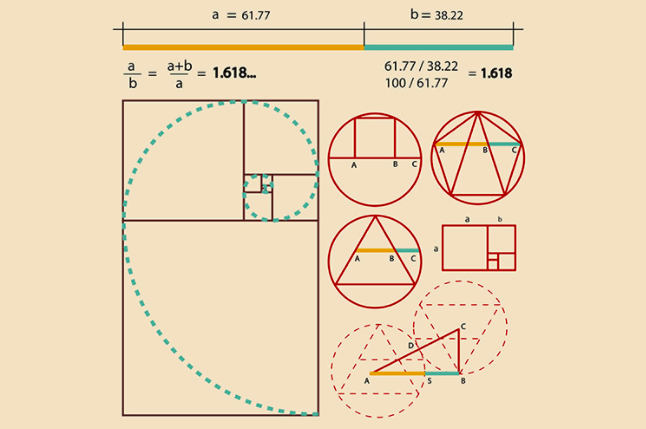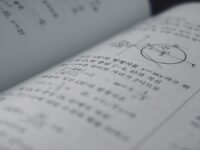To most, irrational numbers seem — well — irrational. We may be familiar with pi (π), Euler’s Number (e), and the square root of two, but a lesser known irrational number may hold many secrets to the universe: the Golden Ratio. From the Pyramids of Giza to the Mona Lisa to vegetables, this number can be found nearly everywhere.
The Golden Ratio occurs when a line is divided in two, where the longer part (a) divided by the shorter part (b) equals the total length of the line (a+b) divided by the longer part (a); a is to b as a+b is to a. It is approximately 1:1.618 and is represented by the Greek letter Φ (Phi). Closely related is the Fibonacci Sequence, a series of numbers where every number is the sum of the two preceding numbers. For example: 1, 1, 2, 3, 5, 8, 13, 21… As the values become larger, the ratio becomes more accurate by accumulating more decimals.
a is to b as a+b is to a
This ratio can be found throughout nature. For instance, the spiral in sunflowers and pinecones follows the Golden Ratio. For both, seeds grow along two intersecting spirals that move in opposite directions, and every seed belongs to both spirals. In pinecones, eight seeds move in a clockwise direction, and thirteen move counterclockwise. In sunflowers, the numbers are even larger (21:34) and more accurate.
The iconic spiral can also be found in hurricanes, seashells, and even the human skull. A 2019 study from John Hopkins University compared 100 human skulls. The Nasioniac arc connects the tip of the nasal bone to the inion, a small bump on the back of the skull, and the Bregma is a curve on the top of the skull that follows a similar path that a headband would. In all of the 100 skulls researchers studied, they found that the bisection of these points creates two arcs whose distances exhibit the Golden Ratio.
Not only is the Golden Ratio embedded in our skulls, research has shown that it is hardwired into our brains.
Not only is the Golden Ratio embedded in our skulls, research has shown that it is hardwired into our brains. Adrian Bejan, professor of mechanical energy at Duke University suggests that evolution has made the human eye capable of interpreting images featuring the Golden Ratio faster than those that do not.
Bejan argues that the human world is oriented horizontally rather than vertically. This is because attacks come from our right, left, back, front, in between far more often than up or down. The scope of vision has evolved accordingly, and the eye takes in information more efficiently when it scans side-to-side. Over time, this field of vision has taken the proportions of the Golden Ratio. Our brain recognizes it and associates it with beauty and harmony without us even knowing.
For this reason, artists and designers take advantage of the aesthetic qualities of the proportion. The earliest known use dates back to 450 BC, when Greek sculptor Phidias used it in his art. Since then, it has been used in paintings like Leonardo Da Vinci’s “Mona Lisa” and Salvador Dali’s “The Sacrament of the Last Supper.” It has also been portrayed in buildings like the Parthenon in Athens, and renowned architect Le Corbusier relied on it for many of his projects.
Peter Wiederspahn, principal of Wiederspahn Architecture LLC and associate professor of architecture at Northeastern University, states that the Golden Ratio is steeped in Renaissance architecture and theory, with much of the inspiration coming from music:
While some call it magical, others call it practical. It is derived from nature and unintelligent systems.
“Sounds are based on intervals of chord progressions,” Wiederspahn said.” Sound is a natural phenomenon, but we can artificially create these phenomena.”
After years of experience in the field, Widerspahn has had an innate sense of the Golden Ratio since the beginning of his architecture practice. While it is applied “conscientiously or subconsciously,” the Golden Ratio makes sense in many designs. While some call it magical, others call it practical. It is derived from nature and unintelligent systems. Our mind’s eye is attracted to natural systems — for example, “a hospital window oriented towards a forest has more benefits to the human psyche than one that faces a parking lot,” said Widersphahn.
Whether we know it or not, the Golden Ratio is all around us, and we use it unknowingly on a daily basis. It raises the questions of why this ratio is so common and how the world, galaxy, and even universe are based on a divine proportion.
Journal of Craniofacial Surgery (2019). DOI: 10.1097/SCS.0000000000005610
International Journal of Design & Nature and Ecodynamics (2009). DOI: 10.2495/DNE-V4-N2-97-104
Computers & Mathematics with Applications (2008). DOI: 10.1016




